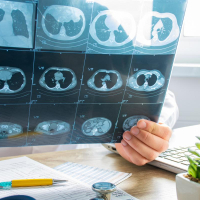
How accurate is chest imaging for diagnosing COVID-19?
Why is this question important?
People with suspected COVID-19 need to know quickly whether they are infected, so that they can self-isolate, receive treatment, and inform close contacts. Currently, formal diagnosis of COVID-19 infection requires laboratory analysis of blood or nose and throat samples. The laboratory test, called RT-PCR, requires specialist equipment and takes at least 24 hours to produce a result. Further, RT-PCR is not completely accurate and a second RT-PCR or a different test may be required to confirm the diagnosis.
COVID-19 is a respiratory infection: people with COVID-19 may have a cough, may have difficulty breathing and in severe cases may have COVID-19 pneumonia. Clinicians use chest imaging tests to diagnose COVID-19 disease, when awaiting RT-PCR test results, for example, or when RT-PCR results are negative, and the person has COVID-19 symptoms.
The authors wanted to find out how accurate chest imaging is in diagnosing COVID-19 disease in people with known or suspected infection.
What are chest imaging tests?
X-rays or scans produce an image of the organs and structures (heart, lungs and airways) in the chest. They can detect blockages, inflammation and excess fluid.
- X-rays (radiography) use a small amount of radiation to produce a 2-D image. They are usually carried out in hospitals using fixed equipment by a radiographer but may also be carried out using a portable machine.
- Computed tomography (CT) scans use a computer to merge multiple X-ray images taken from different angles to produce a 2-D image that can be converted to a 3-D image. They require highly specialised equipment and are carried out in hospital by a specialist radiographer.
- Ultrasound scans use high-frequency sound waves to produce an image. They can be carried out in hospital or other healthcare settings such as a doctor’s surgery or clinic.
What did the authors do do?
The authors of this Review searched for studies that assessed the accuracy of chest imaging to diagnose COVID-19 disease. Studies could include people with either suspected or confirmed COVID-19, based on the results of an RT-PCR or other test. Studies could be of any design and take place anywhere.
What did they find?
The authors found 84 studies with 8279 people. Studies included either only people with confirmed COVID-19 diagnosis (71 studies, involving 6331 people) or both suspected and confirmed COVID-19 (13 studies, involving 1948 people). Infection was mainly confirmed using RT-PCR.
The majority of studies evaluated chest CT. We found studies from all over the world; 78 studies took place in Asia.
Accuracy of chest imaging for diagnosing COVID-19 in people with confirmed infection
On average, chest CT correctly identified infection in 93% of people with confirmed COVID-19 (65 studies, 5759 people). Chest X-ray correctly identified infection in 82% of people with confirmed COVID-19 (nine studies, 682 people). Lung ultrasound correctly identified infection in 100% of people with confirmed COVID-19 (2 studies, 32 people).
Accuracy of chest imaging for diagnosing COVID-19 in people with suspected or confirmed infection
On average, chest CT correctly identified infection in 86% of people who were infected with COVID-19 (13 studies, 2346 people). However, it incorrectly identified infection in 82% of people who were not infected with COVID-19. We did not find any studies that reported data on lung ultrasound.
How reliable are the results?
Studies reported limited information about how they confirmed COVID-19 diagnosis, how they recruited participants, and they did not always use robust methods. Most studies only included people with a confirmed COVID-19 diagnosis, so we have little information about the ability of chest imaging to rule out COVID-19 in people who are not infected. Also, studies did not report any pre-existing respiratory conditions that might have affected their results. Finally, 25% of studies were published as preprints, which do not undergo the same rigorous checks as published studies. The authors cannot confidently draw conclusions based on the results from studies included in this review.
What does this mean?
The evidence suggests that chest CT and chest X-ray may be good tests for confirming COVID-19 diagnosis in people who have been diagnosed with COVID-19 infection using another test. However, CT scans may be less accurate in confirming or ruling out infection in people with only suspected COVID-19.
The authors plan to update this review regularly as more research becomes available.
How up-to-date is this review?
The evidence in this Cochrane Review is current to May 2020.
- Read the full Review on the Cochrane Library
- Listen to the podcast here:
- What are diagnostic test accuracy reviews?
- What is the difference between a Cochrane systematic review of interventions and a Cochrane diagnostic test accuracy review?
This news item was originally posted on the Cochrane website 30 September 2020
The editorial base of the Cochrane Infectious Diseases Group is funded by UK aid from the UK government for the benefit of low- and middle-income countries (project number 300342-104). The views expressed do not necessarily reflect the UK government’s official policies.
